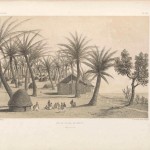The Dibner Library of the History of Science and Technology was created from a gift by Bern Dibner, electrical engineer, inventor, collector, and science historian. At the heart of this collection are Dibner’s “Heralds of Science” , 200 seminal works that Dibner himself believed marked significant scientific advancement in their respective fields. One area that is particularly fascinating is the astronomy section.
Smithsonian Libraries and Archives / Unbound
In honor of Earth Day and National Garden Month, we take a look at one of the lesser known influences in the seed and garden business – the Shaker community.
Gold rush : a multi-page serigraph by Jill Timm. Wenatchee, WA : Mystical Places Press, 2013. This intriguing title Gold Rush, represents three of the Cooper-Hewitt Library’s special collecting interests all more »
Now that Spring has finally arrived, warmer weather is hopefully here to stay. Flowers are beginning to emerge making it the perfect time to sit outside in the garden enjoying the outdoors. Perhaps you are wondering what to plant in your garden. How about a flower with a vibrant color? Or maybe one with a softer look? April is National Garden Month and a perfect time to highlight some of the options.

Huzzah! It’s National Library Week! April 12th-18th has been designated by the American Library Association as a special time to highlight the importance of libraries in America. While we like to think that every week is “library week”, we appreciate the opportunity to celebrate the amazing things that libraries do. We’ll be sharing some fun facts and quotes about libraries in our social media outlets this week – follow along with us using the hashtag #NLW15.
 The blog post, second of three, was written by Xavier Courouble, research assistant for Sailors and Daughters: Early Photography and the Indian Ocean, an online exhibition part of the Smithsonian’s National Museum of African Art’s Connecting the Gems of the Indian Ocean: From Oman to East Africa. Read the first post in the series here.
The blog post, second of three, was written by Xavier Courouble, research assistant for Sailors and Daughters: Early Photography and the Indian Ocean, an online exhibition part of the Smithsonian’s National Museum of African Art’s Connecting the Gems of the Indian Ocean: From Oman to East Africa. Read the first post in the series here.
From 1836 to 1848, successively in command of the corvette “La Prévoyante,” “La Dordogne,” and finally the frigate “Le Ducouëdic,” Charles Guillain (1808-1875) navigated the Indian Ocean from the Cape of Good Hope to the western coast of the Indian sub-continent. During his several missions he accumulated extensive knowledge on Zanzibar, Madagascar, the Comoros, as well as the Swahili and Somali coast of Africa. Accounts of these expeditions were all published and gave this St. Simonien a solid reputation of ethnologist and geographer. Yet a certain degree of confusion remains of the political and commercial purposes of his ambitious campaigns of exploration, influenced by personal convictions, regional aspirations, and France’s global interest in the region.

